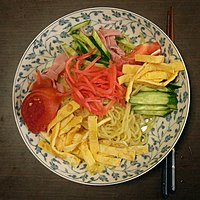
Back Çuka ryori Azerbaijani Gastronomía sino-japonesa Spanish 日本式中華料理 Japanese იაპონურ-ჩინური სამზარეულო Georgian Тюкарёри Kazakh 일본식 중국 요리 Korean Тюкарёри Russian Çin-Japon mutfağı Turkish Японська китайська кухня Ukrainian 日式中餐 Chinese
This article has multiple issues. Please help improve it or discuss these issues on the talk page. (Learn how and when to remove these messages)
|
| Part of a series on |
| Chinese cuisine |
|---|
 |


Japanese Chinese cuisine, also known as chūka, represents a unique fusion of Japanese and Chinese culinary traditions that have evolved over the late 19th century and more recent times. This style, served predominantly by Chinese restaurants in Japan, stands distinct from the "authentic Chinese food" found in areas such as Yokohama Chinatown. Despite this difference, the cuisine retains strong influences from various Chinese culinary styles, as seen in the shippoku cooking style.
A significant number of these dishes were introduced to Japan either by Chinese immigrants or Japanese soldiers returning from the invasion and colonization of China, creating a unique gastronomic landscape that reinterprets Chinese cuisine through a Japanese lens. This style of cuisine has found its expression in three main types of restaurants: ramen restaurants, dim sum houses, and standard Chinese-style restaurants. The resulting adaptations span various regional Chinese cooking styles and techniques, from Sichuan's spicy stir-fries to Zhejiang's slow-cooked stews, contributing to the rich and diverse character of chūka.